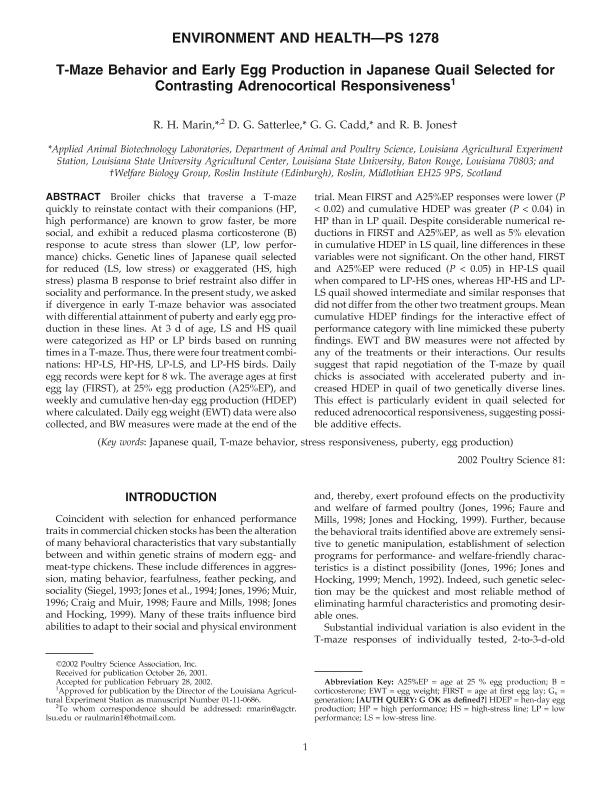Artículo
T-maze behavior and early egg production in Japanese quail selected for contrasting adrenocortical responsiveness
Fecha de publicación:
01/06/2002
Editorial:
Poultry Science Association
Revista:
Poultry Science
ISSN:
0032-5791
e-ISSN:
1525-3171
Idioma:
Inglés
Tipo de recurso:
Artículo publicado
Clasificación temática:
Resumen
Broiler chicks that traverse a T-maze quickly to reinstate contact with their companions (HP, high performance) are known to grow faster, be more social, and exhibit a reduced plasma corticosterone (B) response to acute stress than slower (LP, low performance) chicks. Genetic lines of Japanese quail selected for reduced (LS, low stress) or exaggerated (HS, high stress) plasma B response to brief restraint also differ in sociality and performance. In the present study, we asked if divergence in early T-maze behavior was associated with differential attainment of puberty and early egg production in these lines. At 3 d of age, LS and HS quail were categorized as HP or LP birds based on running times in a T-maze. Thus, there were four treatment combinations: HP-LS, HP-HS, LP-LS, and LP-HS birds. Daily egg records were kept for 8 wk. The average ages at first egg lay (FIRST), at 25% egg production (A25%EP), and weekly and cumulative hen-day egg production (HDEP) where calculated. Daily egg weight (EWT) data were also collected, and BW measures were made at the end of the trial. Mean FIRST and A25%EP responses were lower (P < 0.02) and cumulative HDEP was greater (P < 0.04) in HP than in LP quail. Despite considerable numerical reductions in FIRST and A25%EP, as well as 5% elevation in cumulative HDEP in LS quail, line differences in these variables were not significant. On the other hand, FIRST and A25%EP were reduced (P < 0.05) in HP-LS quail when compared to LP-HS ones, whereas HP-HS and LP-LS quail showed intermediate and similar responses that did not differ from the other two treatment groups. Mean cumulative HDEP findings for the interactive effect of performance category with line mimicked these puberty findings. EWI and BW measures were not affected by any of the treatments or their interactions. Our results suggest that rapid negotiation of the T-maze by quail chicks is associated with accelerated puberty and increased HDEP in quail of two genetically diverse lines. This effect is particularly evident in quail selected for reduced adrenocortical responsiveness, suggesting possible additive effects.
Palabras clave:
Egg Production
,
Japanese Quail
,
Puberty
,
Stress Responsiveness
,
T-Maze Behavior
Archivos asociados
Licencia
Identificadores
Colecciones
Articulos(IIBYT)
Articulos de INSTITUTO DE INVESTIGACIONES BIOLOGICAS Y TECNOLOGICAS
Articulos de INSTITUTO DE INVESTIGACIONES BIOLOGICAS Y TECNOLOGICAS
Citación
Marin, Raul Hector; Satterlee, D. G.; Cadd, G. G.; Jones, R. B.; T-maze behavior and early egg production in Japanese quail selected for contrasting adrenocortical responsiveness; Poultry Science Association; Poultry Science; 81; 7; 1-6-2002; 981-986
Compartir
Altmétricas




